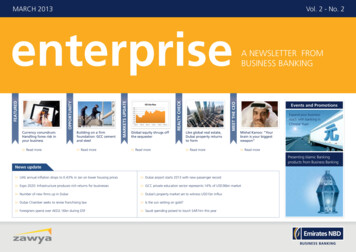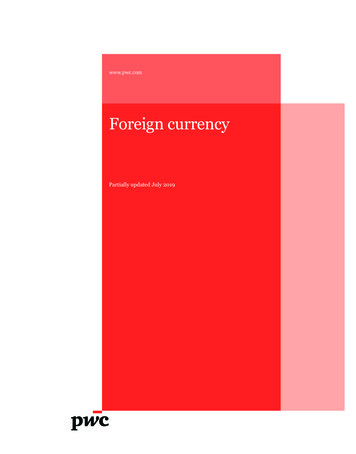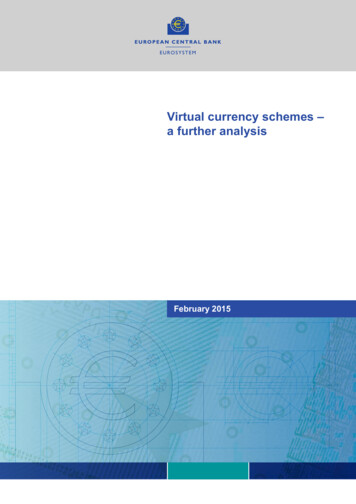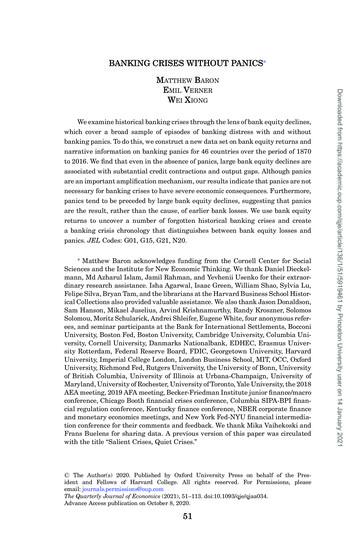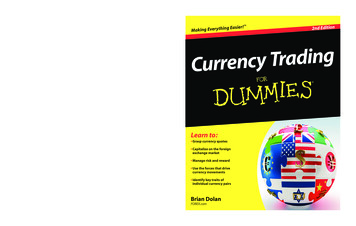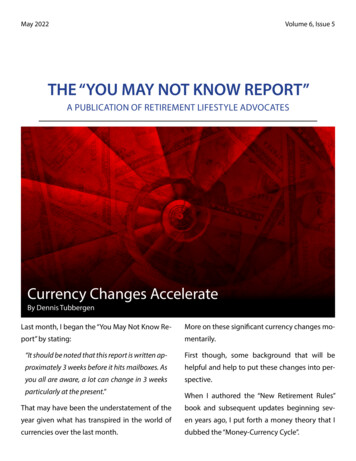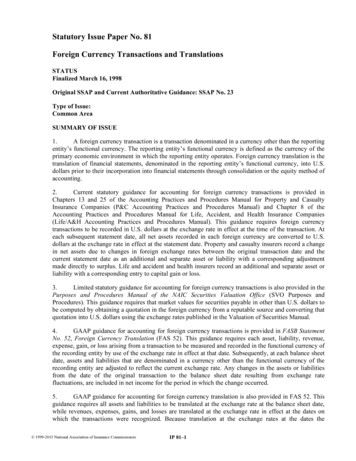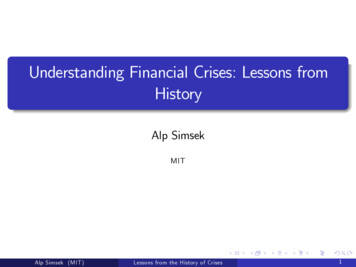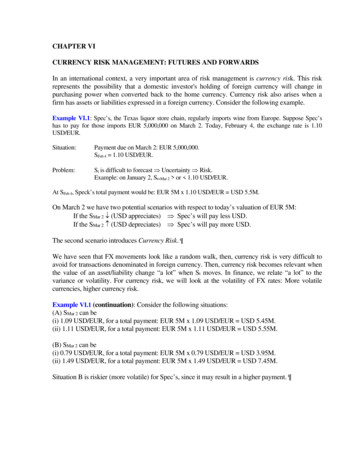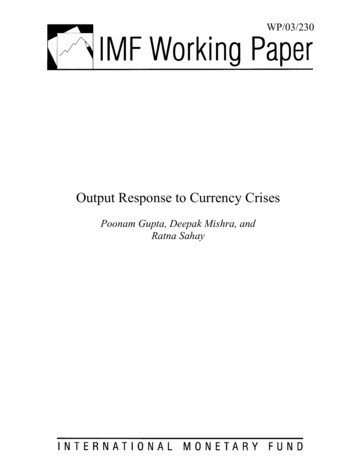
Transcription
WP/03/230Output Response to Currency CrisesPoonam Gupta, Deepak Mishra, andRatna Sahay
2003 International Monetary FundWP/03/230IMF Working PaperResearch DepartmentOutput Response to Currency CrisesPrepared by Poonam Gupta, Deepak Mishra, and Ratna Sahay1November 2003AbstractThe views expressed in this Working Paper are those of the author(s) and do not necessarilyrepresent those of the IMF or IMF policy. Working Papers describe research in progress by theauthor(s) and are published to elicit comments and to further debate.This paper analyzes the behavior of output during currency crises using a sample of 195crisis episodes in 91 developing countries during 1970-98. It finds that more than two-fifthsof the crises in the sample were expansionary, and that output contraction was greater inlarge and more developed economies than in small and less developed economies. Currencycrises have not been any more contractionary in the 1990s than in the previous two decades.Countries that traded less with the rest of the world, that had a relatively open capitalaccount, and where crises were preceded by large capital inflows were more likely to beassociated with contraction during crises. The contraction was more pronounced if tradecompetitors devalued, oil prices rose during the crisis, and postcrisis period was marked bytight monetary policy and expansionary fiscal policy.JEL Classification Numbers: F32, F41, F43Keywords: Currency crises, emerging markets, output growthAuthors’ E-Mail Addresses: pgupta@imf.org; rsahay@imf.org; dmishra@worldbank.org1Poonam Gupta and Ratna Sahay are with the IMF and Deepak Mishra is with the World Bank.The views expressed in this paper are those of the authors and not necessarily of theorganizations with which they are affiliated. They would like to thank Michael Adler,Michael Bordo, Eduardo Borensztein, Enrica Detragiache, Stanley Fischer, Homi Kharas,Amartya Lahiri, Timothy Lane, Prakash Loungani, Paolo Mauro, Gian Maria Milesi-Ferretti,Christian Mulder, Carmen Reinhart, Nouriel Roubini, Sergio Rebelo, Andrew Rose, Xavier Salai-Martin, Carlos Vegh, and Jeromin Zettelmeyer, as well as seminar participants at UC SantaCruz, LACEA, a joint IMF/ World Bank workshop, and the second Annual IMF ResearchConference for many insightful comments. Haiyan Shi provided excellent research assistance.
-2ContentsPageI. Introduction . 3II. Data and (the Not-So-Trivial) Measurement Issues. 4A. Measuring Contractions and Expansions. 5III. Stylized Facts on Growth During Currency Crises. 6A. Contractions and Expansions During Crises. 6B. Severity of Output Crises Over Time. 6C. Severity of Output Crises Across Countries . 7IV. What Explains the Behavior of Output During Crises?. 8A. Liability Dollarization and External Debt Burden. 8B. Sudden Stop or Reversal of External Capital Inflows. 9C. External Liberalization. 9D. Banking Crisis. 9E. Short-Term Debt and Liquidity Crisis. 9F. Devaluation and External Trade . 10G. Monetary and Fiscal Policies . 10H. Business Cycles and Currency Crises . 11V. Econometric Analysis and Results. 11A. Sensitivity Analyses. 14VI. Concluding Remarks . 15Tables1. Changes in Growth Rate: Correlation Coefficient Between Different Measures. 172. Currency Crises and Output Behavior: Stylized Facts . 183. Bi-Variate Regressions . 194. Multivariate Regressions (TM and DC) . 205. Multivariate Regressions (TM, DC, and GC). 216. Multivariate Regressions (TM, DC, GC, and MFP). 227. Descriptive Statistics of (gpost 2 - gpre 3, tranq) Under AlternativeCrisis-Identifying Criteria. 238. Sensitivity Analysis (Alternative Crisis Criteria) . 249. Sensitivity Analysis (Identified Stylized Facts). 25Figures1. Magnitude of Contraction/Expansion During Selected Currency Crises . 262. Frequency Distribution of Average Growth Rate During the Crisis and OnePost-Crisis Year . 273. Frequency Distribution of [g(post 2) - g(pre 3, tranq)].274. Frequency Distribution of [g(post 2) - g(pre 3, tranq)] Under AlternativeCrisis Criteria . 285. Severity of Crises: A Comparison Across Three Decades . 296. Contribution of Various Factors to Output Response to Currency Crisis . 30AppendixesI. Countries in the Sample. 31II. The Crisis Episodes. 32III. Data Sources and Construction of Variables . 33References.34
-3I. INTRODUCTIONThe East Asian currency crises in 1997/98 focused the world’s attention on theeconomy-wide damage such crises can inflict. The Indonesian and Thai economies, forexample, contracted by 13 and 10 percent, respectively, during the crisis.2 Since then,policymakers around the world have been increasingly preoccupied with crisis preventionand management, with the latter focused on minimizing output losses during crises. Morerecently, the output decline during the Argentina crisis (2002) was nearly 11 percent.However, currency crises have not always been contractionary—for example, the crises inBrazil (1979), Colombia (1985), China (1994), Venezuela (1984 and 1987), and Hungary(1993), were associated with higher output growth, as compared with the precrisis period(Figure 1). Why is the output performance so varied, not just in magnitude but even in thedirection it might take?There are several ways in which a currency crisis may affect output. The earlierliterature—through the 1980s—emphasized the beneficial effects arising from the largedepreciation of the domestic currency that characterizes such crises. A depreciation, bycorrecting an overvalued currency or by making the exchange rate more competitive, wasexpected to spur growth by expanding the tradable goods sector. 3 The more recent literaturefocuses on the negative effects: a sudden stop or reversal of capital inflows during a crisiscan slow down growth; a rise in the external debt burden from devaluation in the presenceof liability dollarization can lower investment activity and growth. The slowdown may beworse if the currency crisis is accompanied by a banking crisis, or by a competitivedevaluation by other countries. Moreover, the stance of fiscal and monetary policies pursuedduring crises, and the prevailing global economic environment are also likely to have abearing on growth.Using a broad sample of 195 currency crises in 91 countries from 1970 to 1998, thispaper establishes some stylized facts on the behavior of output growth before and after crises.The paper finds that, while the majority of crises have been contractionary, more than40 percent were expansionary. While growth accelerated in more than half of the crises insmall emerging market countries, the corresponding number for large emerging markets wassomewhat smaller, but still substantial, at 30 percent. To our knowledge, this is the first studyon output response to currency crises that attempts to include as large a sample of crisisepisodes as is available for both emerging markets and low-income countries.On the question of whether the severity of output crises changed over time, ourexpectation was that with increasing financial globalization, the advent of sharp capital flowreversals, and adverse balance sheet effects of sudden devaluations, the positive effects of a2Contraction (expansion) is defined as the difference between the growth rate during thecrisis years and the average growth rate in precrisis tranquil years (See Section III).3See Connolly (1983), Taylor and Rosensweig (1990), Edwards (1986), Morley (1992) andKamin and Klau (1998).
-4devaluation on the tradable goods sector would be insignificant, at least in the short run. Wewere, therefore, surprised to find that the ratio of expansionary to contractionary crises didnot change much in the last three decades—both for large as well as for small emergingmarkets.This paper also attempts to isolate the factors or country characteristics that areassociated with expansionary or contractionary crises. Regression analyses show that growthslowdown is more pronounced when: the bigger the surge in private capital flows prior to thecrisis, the more open the capital and current accounts, the larger the precrisis business cycleboom, and the higher the per capita income of the country. Factors that contribute positivelyto growth are mostly related to international trade. The expansion is stronger when the biggerthe share of external trade in economic activity and the stronger the growth of exports inresponse to devaluation. Among the external factors, competitive devaluation (measured interms of third-country real devaluation), and a rise in crude oil prices have a negative andsignificant impact on growth. Tight monetary policy and expansionary fiscal policy areassociated with adverse growth outcomes. However, the change in the level of fiscal deficitbetween crisis and postcrisis years does not seem to have any bearing on growth.The findings are robust to several sensitivity tests that identify currency crises indifferent ways and use alternative methods of measuring the impact on growth during acrisis. We also control for the size of the external shock itself, by using the change ininternational reserves and nominal depreciation between the crisis and precrisis years asa proxy for the nominal severity of the crisis. The results hold even when the exercise isconducted using different definitions to identify currency crisis dates.One question that this paper is unable to address fully is the policy response to crises,which is likely to be endogenous to growth outcomes. Given the typical fast-pace evolutionof crises, high frequency data would be needed to address the endogeneity issue.Unfortunately, output data for most developing countries are available at annual frequencyonly. Since our primary goal was to establish patterns of output behavior using as large asample of countries as possible, the issue of macroeconomic policy response under currencycrises could not be addressed satisfactorily in this paper.The rest of the paper is organized as follows. Section II explains the methodologyused to identify currency crisis dates and discusses various ways of measuring outputcontraction or expansion. Section III presents the stylized facts on output growth duringcurrency crises. Section IV identifies potential factors that are likely to influence outputgrowth during currency crises, and Section V presents the regression results. Section VIconcludes.II. DATA AND (THE NOT-SO-TRIVIAL) MEASUREMENT ISSUESWe started with a sample of 108 developing countries during 1970-98, drawn fromfour studies on currency crises: Berg and Pattillo (1999), Frankel and Rose (1996), Goldstein,Kaminsky, and Reinhart (2000), and Milesi-Ferretti and Razin (1998), referred to as BP, FR,GKR, and MR, respectively, in this paper. (For a list of countries, see Appendix I.) These
-5studies use somewhat different methodologies to identify currency crises (Appendix II). Forthe purposes of our analysis, we use a simple majority rule to identify the crises dates in the108 countries. Specifically, for a given country, we select a particular year as the crisis yearonly if the majority of these papers identify it as a crisis year. Using this criterion, wedropped 11 countries from our sample as crises in those countries failed to pass the majoritytest.4 The remaining sample of 97 countries had a total of 229 crises. We further dropped34 crisis episodes and 6 countries because data on key variables around the time of the crisiswere not available.5 Thus, we conduct our analysis on 195 crisis episodes in 91 countries(42 African countries, 17 Asian countries, 20 Latin American countries, and 12 countriesfrom Central and Eastern Europe and Middle East), of which, 24 crises occurred in the1970s, 83 in the 1980s, and 88 in the 1990s.6 To check for the robustness of our results,where appropriate, we also report four sets of results based on crises identified in the fourstudies.Data used in this paper were obtained from the IMF’s International FinancialStatistics, and World Economic Outlook, the World Bank's World Development Indicatorsand Global Development Finance, the Economist Intelligence Unit, and JP Morgan’swebsite. Details on the sources and construction of variables are provided in Appendix III.A. Measuring Contractions and ExpansionsTo measure the effect of a currency crisis on growth, we define (gpost n - gpre m) as thedifference in the average growth rate between m precrisis years and n postcrisis years, whereg is the growth rate of real GDP.7 If (gpost n - gpre m) is positive, we call it an expansionaryepisode and if it is negative, it is termed a contractionary episode. We also define (gpost n–gpre m, tranq) as the difference in the average growth rate between the nearest m “tranquil”precrisis years and n postcrisis years, where “tranquil” years exclude any crisis years. Wethen experimented with several different values for m and n and found that these measureswere highly correlated (Table 1). Of the measures listed in Table 1, we found (gpost 2 –gpre 3,tranq) to be the most intuitively appealing. An average of the three precrisis years4Countries excluded from our sample are Barbados, Belize, Djibouti, Grenada, Haiti, Oman,Panama, Seychelles, St. Vincent and Grenadines, Tunisia, and Servia and Montenegro(formerly Yugoslavia).5These countries are Guinea, Israel, Liberia, Samoa, Taiwan Province of China, andVanuatu.6Some of these studies do not cover the period until 1998. Therefore, where possible, weupdate the crises dates until 1998 by using the respective methodologies of the authors.7While we experimented with measures that capture the deviation of growth rate from alinear or nonlinear trend (such as the HP filter), we do not report the results as these measuresseem inappropriate for analyzing the short-run effects of currency crises, in general, or formany developing countries undergoing structural changes frequently.
-6smoothes out large fluctuations that may occur in a particular year (due to, say, a bumperharvest or a natural calamity). Similarly, an average of two postcrisis years, rather thansimply using the first postcrisis year, would take care of the measurement problem that mightarise if a crisis occurred very early or late in a given year.8 In any event, we conductedsensitivity analyses using other measures and found the results to be robust to alternativedefinitions of growth slowdown.Other studies that look at the short-run growth effects of crises have used measuressimilar to ours (for example, see Bordo and Eichengreen, 2001). Studies examining longerrun effects of crises have also used similar precrisis windows, but longer postcrisis windows(Aziz, Caramazza, and Salgado, 2000).III. STYLIZED FACTS ON GROWTH DURING CURRENCY CRISESA. Contractions and Expansions During CrisesWe begin by looking at the frequency distribution of the postcrisis growth rate ofoutput, gpost 2, in Figure 2. It shows that there is a wide variation in postcrisis growth rates,and the distribution approximates a normal distribution.9 Only 28 percent of the crises areassociated with a decline in growth rate and only in 3 percent of the episodes—Nicaragua in1979 and Uruguay in 1982—does the growth rate decline by more than 10 percent.The frequency distribution of gpost 2–gpre 3,tranq , though more skewed toward acontraction, also shows a large variation in the postcrisis growth rates. Figure 3 shows that43 percent of the crises are expansionary and 57 percent of the crises are contractionary inthe sample. Average expansion during the expansionary episodes is 3.5 percent, and averagecontraction during the contractionary episodes is 4.8 percent. Only 6 percent of the crises inthe sample experienced a contraction exceeding 10 percent. This pattern is robust toalternative ways of identifying crises (Figure 4) for the 14 countries that were commonacross the studies.B. Severity of Output Crises Over TimeThe pattern of growth rates has been quite similar in the 1970s, 1980s and 1990s(Figure 5, first panel). The growth rate significantly slows down between the precrisis andcrisis year—by 3 percentage points in the 1970s, 2.5 percentage points in the 1980s, andnearly 2 percentage points in the 1990s. The crisis year is generally the trough of the growthcurve, with the growth rate picking up the year after the crisis and reverting to the precrisis8For example, the real effects of the Mexican crisis of December 1994 would not becaptured, if n 1.9The Jarque-Bera test statistic indicates that the null hypothesis of a normal distributioncannot be rejected.
-7level by the second year after the crisis. A graph of the frequency distribution of (gpost 2–gpre 3,tranq) also seems similar across different decades (Figure 5, second panel), although thenumber of expansions and contractions vary by decades. Given that the recent literature hasfocused more on the contractionary aspects of the crises in the 1990s, it is surprising to seethat 42 percent of the crises were expansionary in the 1990s as compare with 28 percent inthe 1970s and 50 percent in the 1980s.To confirm the pattern described above, we regress (gpost 2 - gpre 3,tranq) on dummiesfor each of the three decades in a simple OLS framework (with heteroskedastically consistentstandard errors). Coefficients of the dummies measure the average contraction/expansionduring crises in the respective decades. As indicated in Table 2, on average, crises have beencontractionary in all three decades. It was somewhat of a surprise to see that the magnitudeof contraction has steadily fallen, from -3.0 in the 1970s to -1.1 in the 1980s to -0.8 in the1990s. However, the null hypothesis that the coefficients are identical across the threedecades is rejected at the 10 percent significance level for only the 1970s compared withthe 1990s. Finally, if we limit the sample to only those crises that were associated with acontraction, the average contraction was not significantly more severe during the 1990sthan in the 1970s or the 1980s. Thus, there does not appear to be any evidence to supportthe popular view that the severity of crises has systematically worsened in the 1990s.We further compare the output response during crisis episodes during which a largenumber of countries were simultaneously affected—namely, the East Asian crisis in 1997,the debt crisis in Latin America (LA) in the 1980s, and the Mexican crisis in 1994.10Interestingly, we find that, though the coefficient of the East Asian crisis is the largest, theaverage contraction during the East Asian crisis is not significantly different from that duringeither the LA debt crisis or the Mexican crisis (Table 2).C. Severity of Output Crises Across CountriesA significant number of large expansions in the sample occurred in low-income,small open economies, several of them in Africa—some examples are Central AfricanRepublic in 1994, Chad in 1981, Ethiopia in1993, Gabon in1981, Ghana in1978, Republicof Congo in 1994, and Senegal in 1981. We categorized countries by the volume of foreigncapital they received during the sample period. To see whether a pattern could be establishedamong countries that were exposed to varying levels of foreign capital, we defined largeemerging markets (LEMs) as countries that received, on average, US 100 million or moreof private external capital flows per year between 1970-98, and small emerging markets(SEMs) as those countries that received less than US 100 million (Appendix I). Indeed,only 30 percent of crises in LEMs, are associated with an expansion as compared with about50 percent in the SEMs.10The LA debt crisis episodes include 1982-83 in the following countries: Argentina,Bolivia, Brazil, Chile, Ecuador, Mexico, and Uruguay. The Mexican crisis event includesArgentina and Mexico in 1994/95. The East Asian crisis includes crises in Indonesia, Korea,Malaysia, Philippines, and Thailand in 1997.
-8-Formally, we regressed (gpost 2 - gpre 3,tranq) on dummies for LEMs and SEMs. Theestimated coefficient for the LEMs dummy variable was –3.07, while that for the SEMsdummy was 0.24 and the two coefficients were statistically significantly different from eachother. In other words, while crises in LEMs have, on average, been contractionary, crises inSEMs were expansionary but insignificant. Finally, by limiting the sample to only LEMs, weconfirm our earlier finding for the whole sample—the average growth contraction duringcrises within LEMs did not change significantly across the three decades (Table 2). Theseresults remain unchanged qualitatively if we redefine LEMs and SEMs on the basis of thesize of the economy (GDP in US ).In summary, while the majority of currency crises in the sample have beencontractionary, a large proportion, more than 40 percent, has been expansionary. Second,there is no significant difference in the ratio of expansionary to contractionary crises in thelast three decades. Contrary to the common view, the crises during the 1990s were not morecontractionary, on average, than the previous two decades. Third, the magnitude ofcontraction in contractionary crises and expansion in expansionary crises has also notchanged significantly in the last three decades. Finally, consistent with popular perception,large emerging markets experienced more contractionary crises than small emerging markets.IV. WHAT EXPLAINS THE BEHAVIOR OF OUTPUT DURING CRISES?How output responds to a currency crisis is likely to depend on a multitude offactors—the conditions prevailing in the real, external, and financial sectors at the timeof the crisis, fiscal and monetary policies implemented during the crisis, and the structuralcharacteristics of the economy. Our empirical analysis relies heavily on the explanationsprovided in the crisis literature, outlined below, that points to several channels of influence.A. Liability Dollarization and External Debt BurdenWhen the liabilities of domestic firms are denominated in foreign currency, adevaluation raises their debt burden. As a consequence, firms find it difficult to serviceexisting debt or raise new loans, which, in the aggregate, is reflected in a decline ininvestment and economic activity.11 Since it is not unusual for developing countries toborrow externally, they are particularly vulnerable to this effect. We attempt to capture thiseffect in our empirical work by including the change in external long-term debt burden asone of the explanatory variables. This variable is measured in two ways—in nominal terms(NOMINAL DEBT) and in real terms (REAL DEBT).11See Bruno (1979), van Wijnbergen (1986), Calvo (1998), and Mishkin (1999).
-9B. Sudden Stop or Reversal of External Capital InflowsCalvo and Reinhart (1999) show that, if a currency crisis is accompanied by a suddenstop or reversal of external capital inflows, and the associated loans to domestic projects isof shorter maturity than the projects themselves, it increases the incidence of nonperformingloans and reduces productive activity. Thus, countries that have been recipients of largecapital inflows are more likely to experience a contraction following a currency crisis.Accordingly, we include the three-year cumulative flow of external private capital prior tothe year of the crisis (CAPFLOW) expressed in percent of GDP as one of the explanatoryvariables.C. External LiberalizationOpen capital accounts undermine the authorities’ ability to prevent capital fromflowing out or to undertake countercyclical policies during currency crises. The severityof the crisis is worse if the capital account was opened without adequately strengtheningdomestic regulations and supervision of financial institutions. To adequately capture thiseffect, we include a variable that proxies controls on foreign exchange and capital accounttransactions (CAPCON), which is used as an interaction term with the private capital flowsvariable in our analysis.12 We want to see whether output crises were more severe incountries with more open capital accounts and experiencing capital flow reversals.D. Banking CrisisIt is not uncommon for the banking sector to come under stress at the time of thecurrency crisis. With devaluation adversely affecting the balance sheets of their clients andincreasing their nonperforming loans, banks may roll back their lending activities, giving riseto a “credit crunch” (Mishkin, 1999). Accordingly, we include a banking crisis dummy(BANK) to see whether its simultaneous occurrence worsened output performance.E. Short-Term Debt and Liquidity CrisisRodrik and Velasco (1999) show that difficulties in rolling over short-term debtduring currency crises could squeeze liquidity in the economy, and shrink the level ofeconomic activity. They find the ratio of short-term external debt to foreign exchangereserves (DEBT RESERVES) to be a robust predictor of financial crises and their severity.13To see whether output is also affectedly adversely, we include DEBT RESERVES in ourregressions.12Capital account restrictions refer to the lack of convertibility of the domestic currency forcapital account transactions. Exchange rate restrictions refer to the regulation of nominalexchange rate or when the country maintains dual or triple exchange rates.13Rodrik and Velasco (1999) define a currency crisis as a significant reversal of externalcapital flows.
- 10 -F. Devaluation and External TradeA devaluation of the currency could restore competitiveness of the economy andprovide a boost to the production of tradables (provided the Marshall-Lerner conditionholds). However, competitiveness increases only if nominal devaluation translates into a realdevaluation of the exchange rate, there is no concurrent devaluation by other competitivecountries, and the effect of devaluation is not offset by a negative terms-of-trade shock.Additionally, the trade regime needs to be sufficiently open to realize the beneficial effectsof the devaluation. 14To test whether devaluation affects output positively via the growth of exports, weuse measures of overvaluation of the exchange rate (against the U.S. dollar, OVERVAL US,and against major trading partners, OVERVAL MULTI), average export growth rate(X GROWTH) during the crisis year and the first postcrisis year, share of trade (exports plusimports) in GDP (OPEN), and a measure of competitive devaluation by other countries(COMP DEVAL) in the regressions.G. Monetary and Fiscal PoliciesMonetary policy is often tightened to stem the extent of speculative attack on thecurrency and to prevent foreign exchange reserves from falling rapidly. Similarly, fiscalpolicy may be tightened during a crisis to signal a strong policy resolve on the part of theauthorities and to compensate for the fiscal burden that inevitably arises following a crisis.While a strong case in favor of tight macroeconomic policies can reasonably be made to stemthe slide of the domestic currency or prevent capital outflows, their effect on output growth isnot obvious.To proxy for monetary and fiscal policies we use percentage change in broad realmoney supply during the crisis ( M2); change in the real interest rate between the crisis yearand the precrisis year
Authors' E-Mail Addresses: pgupta@imf.org; rsahay@imf.org; dmishra@worldbank.org 1 Poonam Gupta and Ratna Sahay are with the IMF and Deepak Mishra is with the World Bank. The views expressed in this paper are those of the authors and not necessarily of the organizations with which they are affiliated. They would like to thank Michael Adler,
